Illinois Students Expose Youngsters to Engineering in BTW's After-School Club
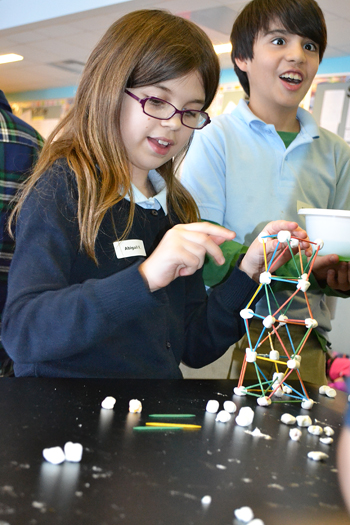
Two BTW students build their tower even taller prior to giving it the final Jello-earthquake-shake test.
February 13, 2014
The after-school Engineering Club at Booker T. Washington STEM Academy (BTW) is a fun, exciting way to expose youngsters to STEM—specifically engineering—early in their school careers…and to introduce the idea that they too might go to college—just like the Illinois engineering students who run the club.
BTW's Engineering Club, run once a week last semester by members of Pi Tau Sigma, a mechanical engineering honor society, now provides twice the fun. Evidently it was so successful that many kids who wanted to participate had to be turned away. So this semester, it's meeting twice: on Tuesdays, Illinois Space Society is teaching the younger students (K–2). The Wednesday session, once again run by Pi Tau Sigma, is for older students (grades 3–5).
The club appears to be a win-win for everyone involved. BTW students get to grapple with challenging engineering activities; Illinois students who teach the club get to give back to the community and to impact some local kids' lives.
For the engineering students, who tend to work quite hard, leaving campus for the short jaunt north to BTW to see engineering through the younger students' eyes appears to be refreshing. For example, MechSE junior, Yang Han says she really enjoys how imaginative the kids are.
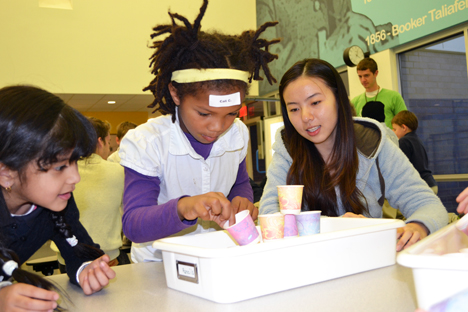
Engineering junior Yang Han (right) works with two BTW students on a project designing a manufacturing system where hot chocolage is "made" automatically by pouring hot water into the top cup, which trickles down to the bottom cups.
"The kids are really creative. I remember last time was amazing. They really came up with some good ideas I couldn't even think of myself. Maybe because they are still really young, they don't have many limits. Because we study and always think a lot, and the kids don't really have to worry that much, so they can be really creative."
Regarding the club's benefit for the kids, Pi Tau Sigma service chair, Julia Huynh, who is in charge of the club for the spring 2014 semester, says "I think it's having a great impact." A senior in Mechanical Engineering, Huynh, who intends to study nanotechnology in grad school once she graduates, believes one of its positives is exposing kids to all the different types of engineering.
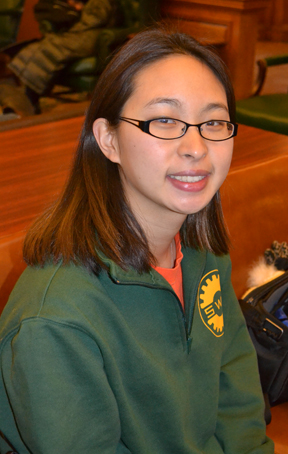
Spring 2014 Pi Tau Sigma service chair, Julia Huynh
Says Huynh, "Personally, for me, even when I was in high school, I still had no idea what engineering was; I had no idea what all the different engineering majors are." So one of the goals of the club is to "Have them get a good feel of what engineering is."
Each week, the club focuses on a different engineering discipline. For example, one week it was civil engineering, and after watching a brief PowerPoint lecture about how to build an earthquake-proof structure, students used marshmallows and toothpicks to build towers that could withstand an "earthquake" when set in a bowl of Jello and vigorously shaken. Another week, they will address bioengineering and do an egg drop and relate it back to helmet safety. On the week they address chemical engineering, the students will be silvering mirrors.
Another goal is to get the kids thinking like engineers. Huynh describes the engineering process they take them through: "So we tell them, 'This is the problem; this is the challenge; come up with a design; spend time designing it; and then build your design; and then test it; and then modify it.' So we take them through that whole process for each of the activities that we have planned for them. So it gets them thinking in an engineering way."
For example, during the session on building earthquake-proof towers, the instructors took the youngsters through the last two steps—testing then modifying their designs—numerous times, emphasizing the strength of a triangle vs. a square or rectangle. Students whose towers toppled during the vigorous shake-in-Jello test (even those whose towers didn't), were challenged to build ever-taller, sturdier models.
Another goal is to get kids interested in STEM and engineering.

Illinois Engineering student Taylor Oltman works with students during a spring 2014 session of the BTW Engineering Club.
"I think it definitely gets them more interested in STEM fields," reports Huynh, "showing them, 'This is engineering. These are all the cool things you can do in engineering. It really gets them more fascinated by it; it gets them fascinated by the technology that we have out there."
Excited about the activity where they make mirrors, Huynh believes the kids will really like it too. They'll actually be making one-way mirrors, just like you see in the interrogation rooms of all the cop shows. "So, for silvering mirrors, we have them make mirrors. But these mirrors are actually—if you've ever seen an interrogation room—they're one way mirrors. So it gets them really interested in it because they see all these cool things we can do with engineering."
Whereas Huynh reports that college students can sometimes be taciturn in class, one of the things she appreciates about working with the BTW students is their enthusiasm.
"It's funny, because you go to college classes, and all the college students in the class, the professor asks them a question—no one raises their hand to answer!" admits Huynh. "But when we teach K–5 students, and we ask them, 'Here's a building. What do you think makes the building strong?', everyone raises their hand and wants to talk, and there are so many ideas. So it's definitely different, and it's nice to see all these kids really interested and fascinated by engineering."
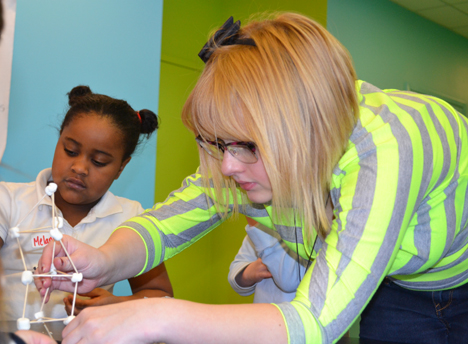
Kelsey White, the outreach director for the Illinois Space Society, works with a team of BTW students on their marshmallow/toothpick tower.
The Tuesday session for the younger kids (K–2) is run by the Illinois Space Society. As its educational outreach director, Kelsey White, a sophomore who is majoring in Aerospace Engineering and Physics, is in charge. Why did White get involved with BTW's Engineering Club? She hopes to pass on her love of STEM to the kids:
"Because I was inspired when I was a kid by math and science, and there wasn't this type of opportunity for me where I grew up. So giving back to these kids, giving them this opportunity is great. And living so close to a university like U of I, they have such great opportunities, and I really want to inspire the kids to have the same passion in math and science that I do."
How did the kids do? Says White, "They did fairly well. Working in teams was a challenge."
White's somewhat qualified response might have been because some children were having difficulty relinquishing their marshmallows to the team; plus, some of the teams' self-appointed leaders weren't particularly gracious when demanding that they do so for the good of the project.)
"But working in teams is such a big part of engineering, though," she continues, "that having them learn how to do it at this age is so much better than me now, having to work with a team. Until last year at school, I've never really worked with a good team on a project. So it's a learning experience for them, not just in engineering, but in working together."
Did she see any future engineers? After a pregnant pause, White responded, "Possibly." (Like this reporter, she too had seen some of the more interesting designs/structures the young children made.)
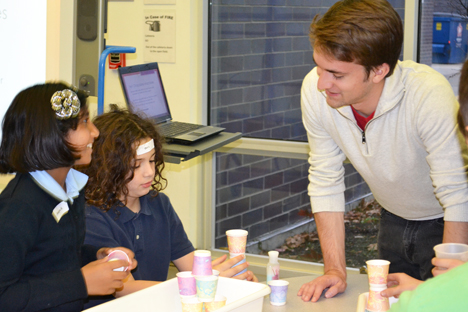
Pi Tau Sigma's Fall 2013 service chair, Nick Kopack, discusses a hands-on engineering project with BTW students.
Unlike White, when Nick Kopack, the Fall 2013 service chair for Pi Tau Sigma, who worked with an older age group, was asked if he could see some of the BTW kids becoming engineers, he responded: "Absolutely." In fact, he's worried they might take his job down the road.
"Pretty much all of these children I talk to, they really like the idea of making something new for themselves and learning new ideas. They're really up to date on current activities too. I'll have a fourth grader come to me and tell me about the new electric motors, and I'm shocked and impressed. So I'm going to have to watch out."
Kopack's favorite part? The relationships he developed with the kids: "This past semester has been amazing: coming to the school, having them pretty much know my name, and I know their name, forming a bond with teaching and new ideas."
Like White, Kopack, says the club was a chance to be a role model for these youngster—just like certain people were in his life. In fact, seeing the youngsters embrace the ideas—learn something new, then make it for themselves—reminds him of himself when he was their age.
"That's really how I was when I was younger. I see a lot of the things I love in what these kids do, so it really speaks to me. I'm doing this because the people I learned from—I really enjoyed that, and I want to be that person too."
Story and photographs by Elizabeth Innes, Communications Specialist, I-STEM Education Initiative.
More: Booker T. Washington, K-6 Outreach, 2014
For more BTW, see the following I-STEM articles:
- Booker T. Washington and Illinois: Partnering to Improve STEM Education
- Booker T. Washington Students Down on the Prairie Fruits Farm
- Outreach-Minded Engineering Students Hope to Steer Local Youth into STEM
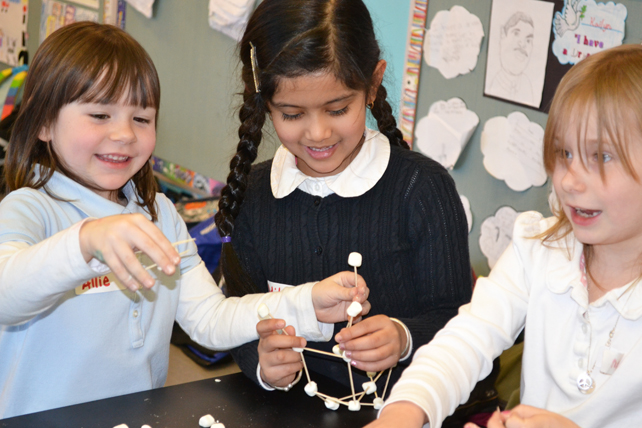
Three BTW students enjoy making their marshmallow/toothpick tower.













.jpg)
















